2018-09-13 - Nº 176

Editorial
Esta é a Newsletter Nº 176 que se apresenta com o mesmo formato que as anteriores. Se gostar da Newsletter partilhe-a!
Todas as Newsletters encontram-se indexadas no link.
Esta Newsletter tem os seguintes tópicos:
Faz hoje anos que nascia, em 1755, Oliver Evans. Este fabricantes de moinhos e inventor americano projectou o primeiro moinho automático de milho, foi pioneiro do motor a vapor de alta pressão e criou a primeira linha de produção contínua (1784). Por volta dos 19 anos, ele inventou uma máquina para dobrar e cortar os fios em pentes para cardagem têxtil. As suas ideias para um moinho de milho automático começaram em 1782, mas o desenvolvimento da invenção não foi concluído até 1790. O engenhoso moinho usou elevadores de balde para fazer subir o grão, transportando dispositivos incluindo um transportador de parafuso horizontal e um funil para arrefecer e secar a refeição antes de juntá-lo numa tremonha que alimenta o cilindro de aparafusamento. Juntos, isto levou trigo e entregou farinha embalada em barris.
Faz também anos hoje que nascia, em 1873, Constantin Carathéodory. Este Matemático alemão de origem grega fez importantes contribuições para a teoria das funções reais e para a teoria da medida do ponto. Ele demonstrou que o cálculo das variações (a teoria dos máximos e mínimos nas curvas) poderia ser aplicado não apenas para suavizar as curvas, mas também para as curvas. Ele também contribuiu para a termodinâmica e ajudou a desenvolver a teoria da relatividade especial de Einstein.
Faz igualmente anos hoje que nascia, em 1885, Wilhelm Blaschke. Este Matemático alemão contribuiu de forma muito relevante para a geometria no que diz respeito à cinemática e à geometria diferencial. O mapeamento cinético (importante posteriormente nos fundamentos axiomáticos de várias geometrias) foi por ele descoberto e estabeleceu-o como uma ferramenta na cinemática. Ele também iniciou a geometria diferencial topológica (o estudo de mapeamentos invariavelmente diferenciados).
Faz também anos que nascia, em 1886, Robert Robinson. Este Químico inglês recebeu o Prémio Nobel da Química de 1947 pela sua pesquisa numa ampla gama de compostos orgânicos, nomeadamente alcaloides (complexos compostos naturais que contêm nitrogénio e que podem ter efeitos profundos nos seres vivos). Nas suas primeiras pesquisas, ele estudou pigmentos de plantas e antocianinas e flavonas sintetizadas. Mais tarde, trabalhando com alcaloides, ele descobriu as estruturas da morfina (1925) e estricnina (1946).
Por fim, faz anos hoje que nascia, em 1912, Horace W. Babcock. Este astrónomo americano era filho de Harold Babcock. Trabalhando juntos, eles foram os primeiros a medir a distribuição de campos magnéticos sobre a superfície do sol. Horace inventou e construiu muitos instrumentos astronómicos, incluindo um mecanismo de medição que produzia excelentes matriz de difracção, o magnetógrafo solar e microfotómetros, orientadores automáticos e medidores de exposição para os telescópios de 100 e 200 polegadas. Ao combinar o seu analisador polarizador com o espectrógrafo, ele descobriu campos magnéticos noutras estrelas. Ele desenvolveu modelos importantes de manchas solares e seu magnetismo, e foi o primeiro a propor óptica adaptativa (1953).
Esta semana ficámos a saber que a Inteligência Artificial ajudou a Encontrar Novas ondas de Rádio vinda do espaço longicuo. Algoritmos de ML aplicados a dados do Telescópio Green Bank encontram novos pulsos da misteriosa fonte de rádio FRB 121102. Estes 72 sinais de rádio podem ser de civilizações extraterrestres. Esta informação foi localizada após uma analise de um grande volume de dados de cerca de 400 terabytes relativos a ondas de rádio emitidas a partir de uma galáxia anã a cerca de 3000 milhões de anos-luz da Terra.
Também esta semana ficámos a conhecer o projecto Vera da Volvo Trucks. Esta nova solução de transporte consiste em veículos comerciais eléctricos autónomos que podem contribuir para um transporte mais eficiente, seguro e limpo. O objetivo de longo prazo é oferecer às empresas que precisam de serviços de transporte contínuos entre hubs fixos um complemento às ofertas de hoje. A operação é feita por veículos eléctricos autónomos ligados a um serviço de cloud e a um centro de controle de transporte. Os veículos são equipados com sofisticados sistemas de condução autónoma. Eles são projectados para localizar sua posição atual em centímetros, monitorizar detalhadamente e analisar o que está a acontecer com outros veículos da estrada e, em seguida, responder com alta precisão.
Na Newsletter desta semana apresentamos diversos projetos de maker assim como alguns modelos 3D que poderão ser úteis. É apresentada a revista newelectronics de 12 de Setembro.
 João Alves ([email protected])
João Alves ([email protected])
O conteúdo da Newsletter encontra-se sob a licença  Creative Commons Attribution-NonCommercial-ShareAlike 4.0 International License.
Creative Commons Attribution-NonCommercial-ShareAlike 4.0 International License.
Novidades da Semana
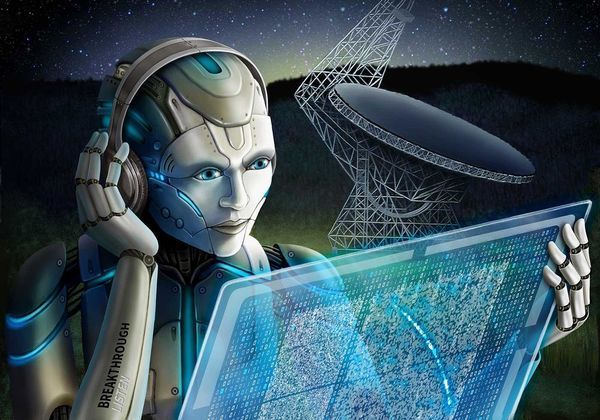
Artificial Intelligence Helps Find New Fast Radio Bursts
"Machine learning algorithms applied to data from the Green Bank Telescope find new pulses from the mysterious repeating source FRB 121102. Researchers at Breakthrough Listen – the initiative to find signs of intelligent life in the universe – have applied machine learning techniques to detect 72 new fast radio bursts emanating from the "repeater" FRB 121102. Fast radio bursts, or FRBs, are bright pulses of radio emission, just milliseconds in duration, thought to originate from distant galaxies. Most FRBs have been witnessed during just a single outburst. In contrast, FRB 121102 is the only one to date known to emit repeated bursts, including 21 seen during Breakthrough Listen observations made in 2017 with the Green Bank Telescope (GBT) in West Virginia[1]. The results of this research have been accepted for publication in the Astrophysical Journal and will be available on the arXiv service on Monday 10 September, 2018." [...]
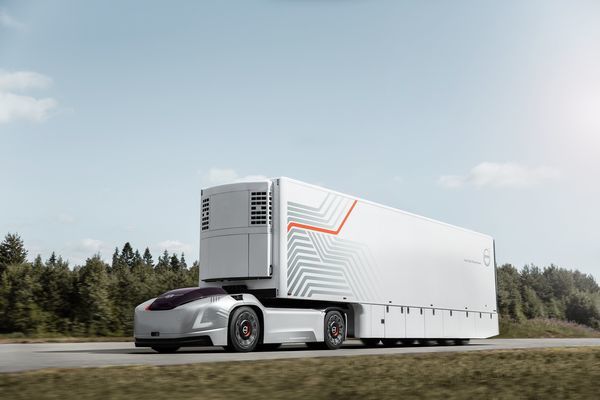
Volvo Trucks Presents Future Transport Solution With Autonomous Electric Vehicles
"Volvo Trucks is now presenting a new transport solution consisting of autonomous electric commercial vehicles that can contribute to more efficient, safer and cleaner transportation. The long-term goal is to offer companies that need continuous transport services between fixed hubs a complement to today’s offerings. Growing world population and increasing urbanisation are leading to significant challenges to solve environmental issues such as congestion, pollution and noise. Rising consumption, the fast growth of e-commerce and the wide-spread shortage of drivers put higher demands on efficient transport solutions. "The full potential of the transport industry is yet to be seen. Everything suggests that the global need for transportation will continue to significantly increase in the coming decade." [...]
Outras Notícias
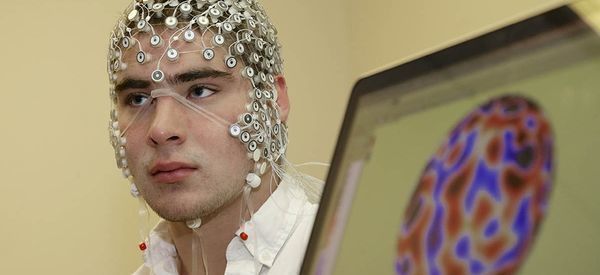
It's Now Possible To Telepathically Communicate with a Drone Swarm
"DARPA’s new research in brain-computer interfaces is allowing a pilot to control multiple simulated aircraft at once. A person with a brain chip can now pilot a swarm of drones — or even advanced fighter jets, thanks to research funded by the U.S. military’s Defense Advanced Research Projects Agency, or DARPA. The work builds on research from 2015, which allowed a paralyzed woman to steer a virtual F-35 Joint Strike Fighter with only a small, surgically-implantable microchip. On Thursday, agency officials announced that they had scaled up the technology to allow a user to steer multiple jets at once. “As of today, signals from the brain can be used to command and control … not just one aircraft but three simultaneous types of aircraft,” said Justin Sanchez, who directs DARPA’s biological technology office, at the Agency’s 60th-anniversary event in Maryland. More importantly, DARPA was able to improve the interaction between pilot and the simulated jet to allow the operator, a paralyzed man named Nathan, to not just send but receive signals from the craft." [...]

Renesas to Acquire Integrated Device Technology, to Enhance Global Leadership in Embedded Solutions
"Renesas Electronics Corporation (“Renesas”, TSE: 6723), a premier supplier of advanced semiconductor solutions, and Integrated Device Technology, Inc. (“IDT”, NASDAQ: IDTI), a leading supplier of analog mixed-signal products including sensors, connectivity and wireless power, today announced they have signed a definitive agreement under which Renesas will acquire IDT for US$49.00 per share in an all-cash transaction representing an equity value of approximately US$6.7 billion (approximately 733.0 billion yen at an exchange rate of 110 yen to the dollar). The acquisition combines two recognized leaders in embedded processors and analog mixed-signal semiconductors, each with unique strengths in delivering products to improve performance and efficiency in high-computing electronic systems. The boards of directors of both companies have unanimously approved the transaction. Closing of the transaction is expected to occur in the first half of 2019, following approvals by IDT shareholders and the relevant regulatory authorities. Since 2016, Renesas has been executing its growth strategy to thrive in the global marketplace and become a global leading embedded solution provider. As part of this initiative, Renesas is working to expand its analog solution lineup and to strengthen its kit solution offerings that combine its microcontrollers (MCUs), system-on-chips (SoCs) and analog products." [...]

NEXT Future Transportation unveils autonomous Parcel Delivery Solution
"NEXT Future Transportation Inc. ('NEXT'), the world's only modular electric vehicle solutions provider, today announced a groundbreaking automated logistics solution for Smart and Connected Cities. NEXT is proud to announce the introduction of its fully automated multiservice 'online-to-offline' (O2O) platform, including a modular vehicle solution and the supporting operating system required to bring an ecosystem of logistics services to market at scale. "To date NEXT has entirely focused on creating innovative solutions for the municipal mass transportation market. Today NEXT enters the global USD $2.3 trillion e-commerce market, which is driving a rapid transformation of the traditional retail supply chain," said Emmanuele Spera, CEO of NEXT. Built on NEXT's patented modular transportation platform, the logistics solution is an automated electric vehicle system that is designed to be customizable and scalable for a wide range of Mobility-as-a-Service (MaaS) applications. A fully integrated logistics solution, NEXT compliments warehouse optimization strategies, and workflow environments of Third Party Logistics (3PL), Retailers and Manufacturers." [...]
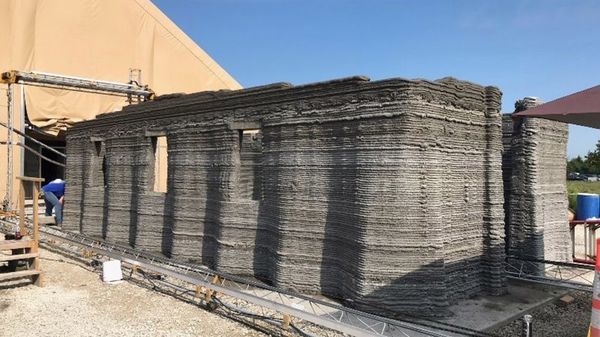
US military 3D prints concrete barracks on site
"In a world first, the US Armed Forces has 3D printed a barracks out of concrete on site at an army base, in less than two days. The Marine Corps Systems Command (MCSC) constructed the 46-square-metre building in 40 hours at the US Army Engineer Research and Development Center in Champaign, Illinois. "This is the first-in-the-world on-site continuous concrete print," said Captain Matthew Friedell, a project officer from the MCSC additive manufacturing team. "People have printed buildings and large structures, but they haven't done it on-site and all at once." The barracks has a slightly undulating facade with visible striations where the printer has added layer upon layer of concrete. The MCSC teamed up with a task force from the marines to build the barracks, which required four people to supervise and refill the printer with concrete over the course of the 40 hours." [...]
Ciência e Tecnologia
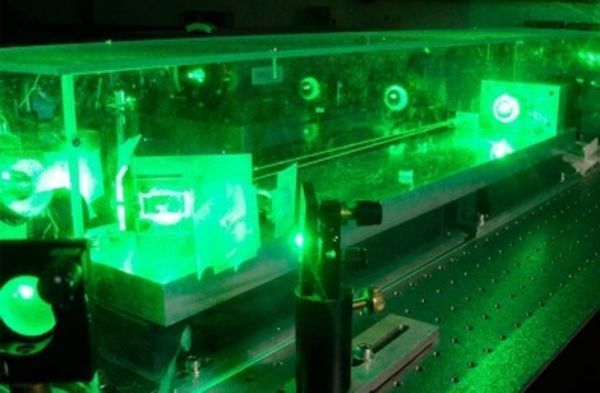
Experiment obtains entanglement of six light waves with a single laser
"Austrian physicist Erwin Schrödinger (1887-1961), one of the giants of contemporary science, considered “entanglement” the most interesting property in quantum mechanics. In his view, it was this phenomenon that truly distinguished the quantum world from the classical world. Entanglement occurs when groups of particles or waves are created or interact in such a way that the quantum state of each particle or wave cannot be described independently of the others, however far apart they are. Experiments performed at the University of São Paulo’s Physics Institute (IF-USP) in Brazil have succeeded in entangling six light waves generated by a simple laser light source known as an optical parametric oscillator. Articles about these experiments have been published in Physical Review Letters (“Hexapartite entanglement in an above-threshold optical parametric oscillator”) and Physical Review A (“Exploring six modes of an optical parametric oscillator”). The experiments are highlighted in a special news feature posted to the publications’ website." [...]
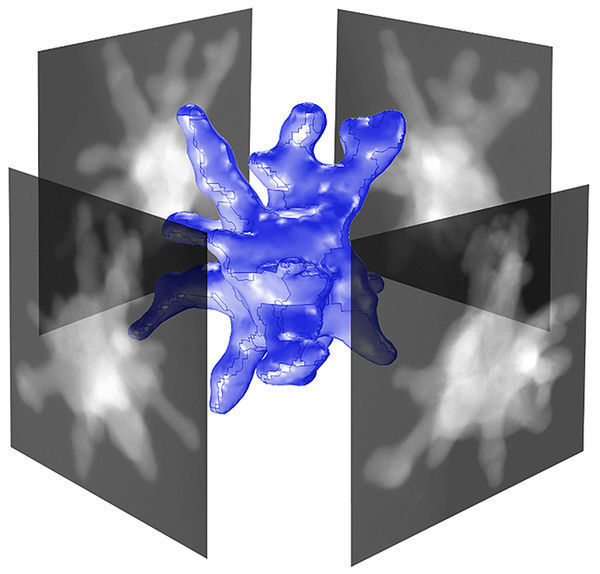
Getting an Up-Close, 3-D View of Gold Nanostars
"Scientists can now measure 3-D structures of tiny particles with properties that hold promise for advanced sensors and diagnostics. The Science Extremely small structures, far smaller in diameter than a strand of hair, could greatly benefit sensors and other devices. To master these nanomaterials, scientists need to determine their shape. That’s difficult. Scientists developed a new way to perform high-resolution, 3-D imaging of tiny metallic structures. The method uses scanning transmission electron microscopy (STEM)." [...]

Robots can now pick up any object after inspecting it
"Breakthrough CSAIL system suggests robots could one day be able to see well enough to be useful in people’s homes and offices. Humans have long been masters of dexterity, a skill that can largely be credited to the help of our eyes. Robots, meanwhile, are still catching up. Certainly there’s been some progress: For decades, robots in controlled environments like assembly lines have been able to pick up the same object over and over again. More recently, breakthroughs in computer vision have enabled robots to make basic distinctions between objects. Even then, though, the systems don’t truly understand objects’ shapes, so there’s little the robots can do after a quick pick-up." [...]

Graphene enables clock rates in the terahertz range: researchers pave the way for nanoelectronics of the future
"Graphene – an ultrathin material consisting of a single layer of interlinked carbon atoms – is considered a promising candidate for the nanoelectronics of the future. In theory, it should allow clock rates up to a thousand times faster than today’s silicon-based electronics. Scientists from the Helmholtz Zentrum Dresden-Rossendorf (HZDR) and the University of Duisburg-Essen (UDE), in cooperation with the Max Planck Institute for Polymer Research (MPI-P), have now shown for the first time that graphene can actually convert electronic signals with frequencies in the gigahertz range – which correspond to today’s clock rates – extremely efficiently into signals with several times higher frequency. The researchers present their results in the scientific journal „Nature“ vor. Today’s silicon-based electronic components operate at clock rates of several hundred gigahertz (GHz), that is, they are switching several billion times per second. The electronics industry is currently trying to access the terahertz (THz) range, i.e., up to thousand times faster clock rates." [...]

First truly black solar modules roll off industrial production line
"Joint European R&D team shows that black silicon with reflectance below 1% is ready for industrial solar panel production. A 2011 invention made by Aalto University’s researchers has proceeded from concept to reality. Just a few years ago, the researchers obtained the record efficiency of 22% in the lab for nanostructured solar cells using atomic layer deposition. Now with the help of industrial partners and joint European collaboration, the first prototype modules have been manufactured on an industrial production line. 'Our timing could not have been better,' Professor Hele Savin, who led the research, was pleased to share. Indeed, 2018 is commonly called the 'Year of Black Silicon' due to its rapid expansion in the photovoltaic (PV) industry." [...]
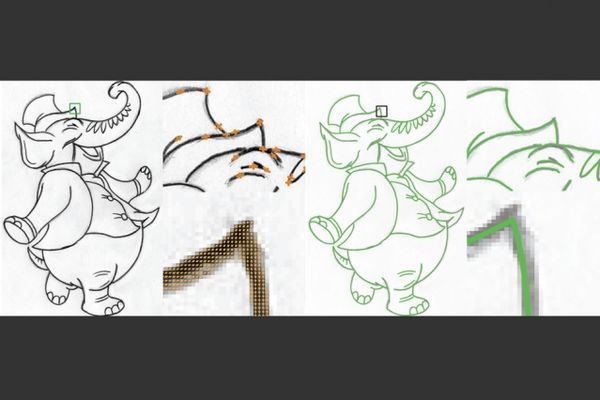
Smoothing out sketches' rough edges
"MIT-developed tool improves automated image vectorization, saving digital artists time and effort. Artists may soon have at their disposal a new MIT-developed tool that could help them create digital characters, logos, and other graphics more quickly and easily. Many digital artists rely on image vectorization, a technique that converts a pixel-based image into an image comprising groupings of clearly defined shapes. In this technique, points in the image are connected by lines or curves to construct the shapes. Among other perks, vectorized images maintain the same resolution when either enlarged or shrunk down. To vectorize an image, artists often have to hand-trace each stroke using specialized software, such as Adobe Illustrator, which is laborious." [...]
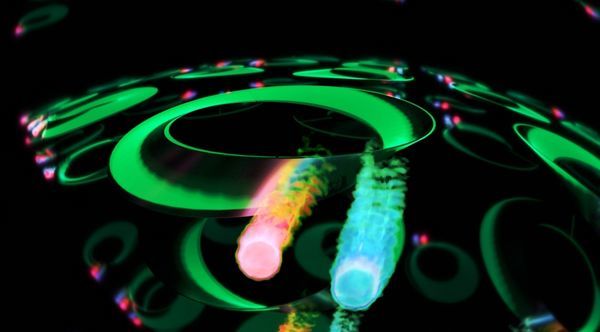
Pristine quantum light source created at the edge of silicon chip
"The smallest amount of light you can have is one photon, so dim that it’s pretty much invisible to humans. While imperceptible, these tiny blips of energy are useful for carrying quantum information around. Ideally, every quantum courier would be the same, but there isn’t a straightforward way to produce a stream of identical photons. This is particularly challenging when individual photons come from fabricated chips. Now, researchers at the Joint Quantum Institute (JQI) have demonstrated a new approach that enables different devices to repeatedly emit nearly identical single photons. The team, led by JQI Fellow Mohammad Hafezi, made a silicon chip that guides light around the device’s edge, where it is inherently protected against disruptions." [...]

Holography, Light-Field Technology Combo Could Deliver Practical 3-D Displays
"While most interaction with digital content is still constrained to keyboards and 2-D touch panels, augmented and virtually reality (AR/VR) technologies promise ever more freedom from these limitations. AR/VR devices can have their own drawbacks, such as a tendency to induce visual motion sickness or other visual disturbances with prolonged usage due to their stereoscopy or auto-stereoscopy based designs. One promising solution is to adapt holography or light field technology into the devices instead. This, however, requires additional optics that would increase the size, weight, and cost of these devices -- challenges that have so far prevented these devices from achieving commercial success. Now, a group of researchers in Japan and Belgium has begun to explore a combination of holography and light field technologies as a way to reduce the size and cost of more people-friendly AR/VR devices. They will present their work during The Optical Society’s (OSA) Frontiers in Optics meeting, 16–20 September, in Washington, D.C. One of the themes of the meeting is virtual reality and augmented vision, with both a visionary speaker and a series of invited talks on those subjects." [...]

Diamond dust enables low-cost, high-efficiency magnetic field detection
"UC Berkeley engineers have created a device that dramatically reduces the energy needed to power magnetic field detectors, which could revolutionize how we measure the magnetic fields that flow through our electronics, our planet and even our bodies. “The best magnetic sensors out there today are bulky, only operate at extreme temperatures and can cost tens of thousands of dollars,” said Dominic Labanowski, who helped create the device, which is made from nitrogen-infused diamonds, as a postdoctoral researcher in the Department of Electrical Engineering and Computer Science. “Our sensors could replace those more-difficult-to-use sensors in a lot of applications from navigation to medical imaging to natural resource exploration.” Each time a diamond-based sensor measures a magnetic field, it must first be blasted with 1 to 10 watts of microwave radiation to prime them to be sensitive to magnetic fields, which is enough power to melt electronic components. The researchers found a new way to excite tiny diamonds with microwaves using 1,000 times less power, making it feasible to create magnetic-sensing devices that can fit into electronics like cell phones. This work was led by the lab of EECS professor Sayeef Salahuddin at UC Berkeley in collaboration with researchers from the Ohio State University. The team reports their device online Sep. 7 in the journal Science Advances." [...]
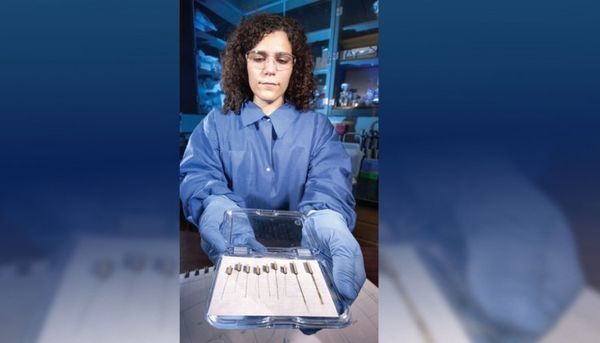
Electrochemical 'roughening' improves LLNL-developed flexible biological sensors
"Lawrence Livermore National Laboratory (LLNL) engineers and scientists have developed a new technique that enhances the performance of Lab-developed flexible thin-film biological sensors, increasing the sensitivity of the implantable arrays to chemicals for biosensing applications, among other performance improvements. In the latest edition of the Journal of the Electrochemical Society, LLNL researchers report on results achieved by electrochemically “roughening” the Lab-developed platinum multielectrode arrays, which resulted in increased surface area, enhanced capability to record and stimulate cell activity with the electrodes and improved adhesion of metal coatings. By placing the electrode arrays in an electrolyte solution and subjecting them to oxidation-reduction electrical pulses, researchers were able to enhance surface area by 44 times and improve detection of hydrogen peroxide by nearly three times due to greater electron transfer. Researchers said the increased performance can enable detection of very small neurotransmitter concentrations in the brain or other chemicals of interest in the urine or other bodily fluids, allowing for quicker detection if chemical levels drift out of a healthy range. The research also marks the first time this level of performance enhancement was possible with roughening of thin film electrodes. “We modified the same process that was used for roughening of foils for decades to roughen thin film electrodes that are much more delicate in nature." [...]

Artificial intelligence system uses transparent, human-like reasoning to solve problems
"Model from MIT Lincoln Laboratory Intelligence and Decision Technologies Group sets a new standard for understanding how a neural network makes decisions. A child is presented with a picture of various shapes and is asked to find the big red circle. To come to the answer, she goes through a few steps of reasoning: First, find all the big things; next, find the big things that are red; and finally, pick out the big red thing that’s a circle. We learn through reason how to interpret the world. So, too, do neural networks. Now a team of researchers from MIT Lincoln Laboratory's Intelligence and Decision Technologies Group has developed a neural network that performs human-like reasoning steps to answer questions about the contents of images." [...]
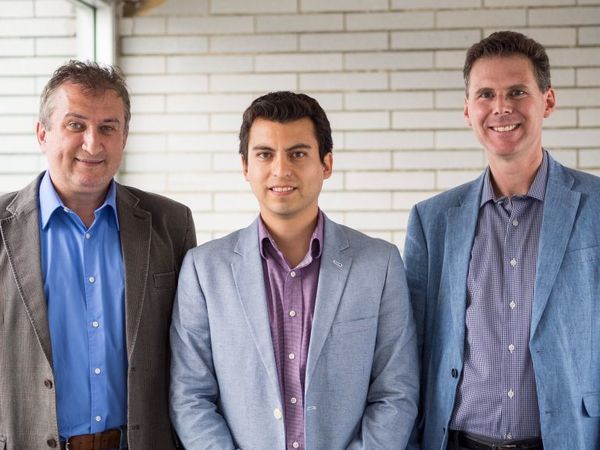
Could a DIY ultrasound be in your future? UBC breakthrough opens door to $100 ultrasound machine
"Engineers at the University of British Columbia have developed a new ultrasound transducer, or probe, that could dramatically lower the cost of ultrasound scanners to as little as $100. Their patent-pending innovation—no bigger than a Band-Aid—is portable, wearable and can be powered by a smartphone. Conventional ultrasound scanners use piezoelectric crystals to create images of the inside of the body and send them to a computer to create sonograms. Researchers replaced the piezoelectric crystals with tiny vibrating drums made of polymer resin, called polyCMUTs (polymer capacitive micro-machined ultrasound transducers), which are cheaper to manufacture. “Transducer drums have typically been made out of rigid silicon materials that require costly, environment-controlled manufacturing processes, and this has hampered their use in ultrasound,” said study lead author Carlos Gerardo, a PhD candidate in electrical and computer engineering at UBC. “By using polymer resin, we were able to produce polyCMUTs in fewer fabrication steps, using a minimum amount of equipment, resulting in significant cost savings.” Sonograms produced by the UBC device were as sharp as or even more detailed than traditional sonograms produced by piezoelectric transducers, said co-author Edmond Cretu, professor of electrical and computer engineering." [...]
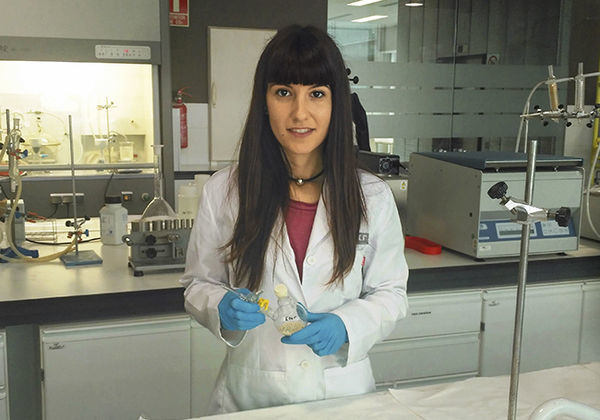
Smart fabrics thanks to materials with shape memory
"A study by the UPV/EHU-University of the Basque Country has synthesised polyurethanes with shape memory for the textile and footwear industry Using shape-memory polyurethanes, the UPV/EHU researcher Míriam Sáenz-Pérez has synthesised various fibres and fabrics that promote sweat evaporation and humidity control and display recovery in excess of 99 %. Shape memory is a very interesting property making it possible to develop materials that change shape when they are subjected to an external stimulus (thermal, electrical, magnetic, etc.). In recent years, polymers with shape memory have been the focus of attention owing to their outstanding functionality and the possibilities they offer as smart materials. Among them, “shape-memory polyurethanes are a class of polymers that can be synthesised with different types of molecular architectures by varying their composition and by correctly selecting the chemical structure of their components. This gives rise to a range of applications in the automotive sector, biomedicine, adhesives, and the textile or footwear industry", remarked Míriam Sáenz-Pérez, a researcher in the UPV/EHU’s Department of Physical Chemistry and who currently works at the Footwear Research Centre in La Rioja. This work focussed on exploring shape-memory polyurethanes for applications in smart fabrics." [...]
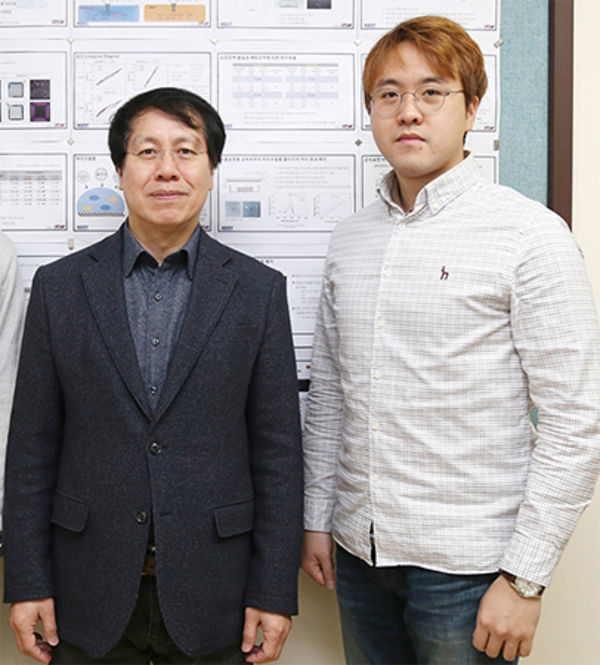
KAIST First Reveals Principles behind Electron Heating in Weakly Ionized Collisional Plasmas
"A KAIST research team successfully identified the underlying principles behind electron heating, which is one of the most important phenomena in plasmas. As the electric heating determines wide range of physical and chemical properties of plasmas, this outcome will allow relevant industries to extend and effectively customize a range of plasma characteristics for their specific needs. Plasma, frequently called the fourth state of matter, can be mostly formed by artificially energizing gases in standard temperature (25°C) and pressure (1 atm) range. Among the many types of plasma, atmospheric-pressure plasmas have been gaining a great deal of attention due to their unique features and applicability in various scientific and industrial fields. Because plasma characteristics strongly depends on gas pressure in the sub-atmospheric to atmospheric pressure range, characterizing the plasma at different pressures is a prerequisite for understanding the fundamental principles of plasmas and for their industrial applications. In that sense, information on the spatio-temporal evolution in the electron density and temperature is very important because various physical and chemical reactions within a plasma arise from electrons." [...]
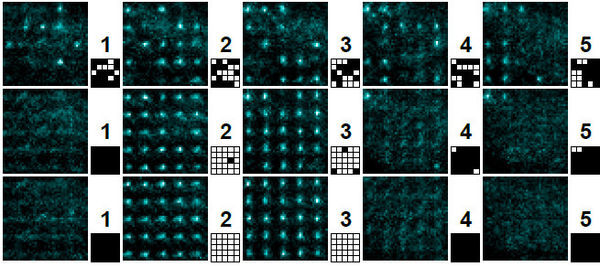
Could a 'demon' help to create a quantum computer?
"Reduced entropy in a three-dimensional lattice of super-cooled, laser-trapped atoms could help speed progress toward creating quantum computers. A team of researchers at Penn State can rearrange a randomly distributed array of atoms into neatly organized blocks, thus performing the function of a “Maxwell’s demon” — a thought experiment from the 1870s that challenged the second law of thermodynamics. The organized blocks of atoms could form the basis for a quantum computer that uses uncharged atoms to encode data and perform calculations. A paper describing the research appears Sept. 6, 2018 in the journal Nature. “Traditional computers use transistors to encode data as bits that can be in one of two states — zero or one,” said David Weiss, professor of physics at Penn State and the leader of the research team. “We are devising quantum computers that use atoms as ‘quantum bits’ or ‘qubits’ that can encode data based on quantum mechanical phenomena that allow them to be in multiple states simultaneously." [...]
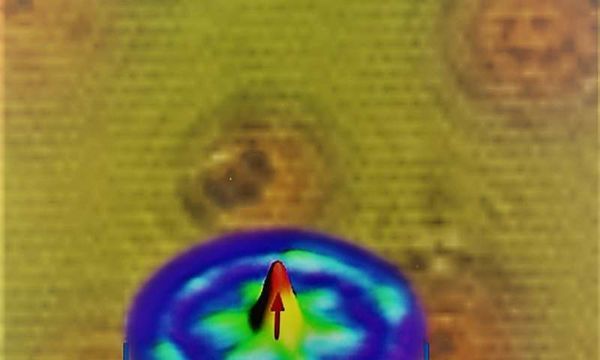
Scientists discover a 'tuneable' novel quantum state of matter
"Quantum particles can be difficult to characterize, and almost impossible to control if they strongly interact with each other—until now. An international team of researchers led by Princeton physicist Zahid Hasan has discovered a quantum state of matter that can be "tuned" at will—and it's 10 times more tuneable than existing theories can explain. This level of manipulability opens enormous possibilities for next-generation nanotechnologies and quantum computing. "We found a new control knob for the quantum topological world," said Hasan, the Eugene Higgins Professor of Physics. "We expect this is tip of the iceberg. There will be a new subfield of materials or physics grown out of this." [...]
Modelos 3D
Com a disponibilidade de ferramentas que permitem dar azo a nossa imaginação na criação de peças 3D e espaços como o thingiverse para as publicar, esta rubrica apresenta alguns modelos selecionados que poderão ser úteis.
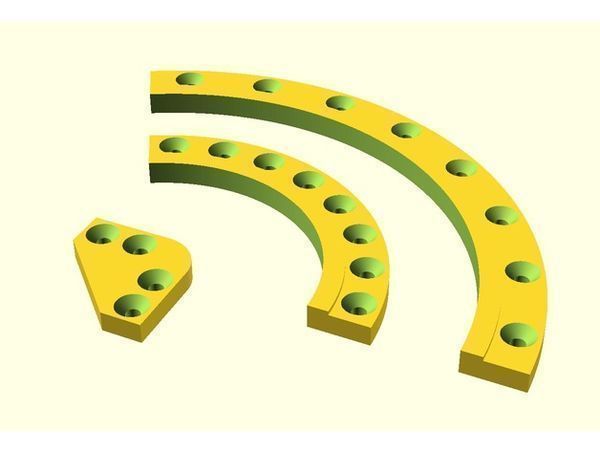
seven segment parametric OpenSCAD (7 segment)
"Fully parametric OpenSCAD library for 7 segment digits. It is not for direct print. It is designed to reuse in your design. Enjoy! " [...]
Documentação
A documentação é parte essencial do processo de aprendizagem e a Internet além de artigos interessantes de explorar também tem alguma documentação em formato PDF interessante de ler. Todos os links aqui apresentados são para conteúdo disponibilizado livremente pelo editor do livro.
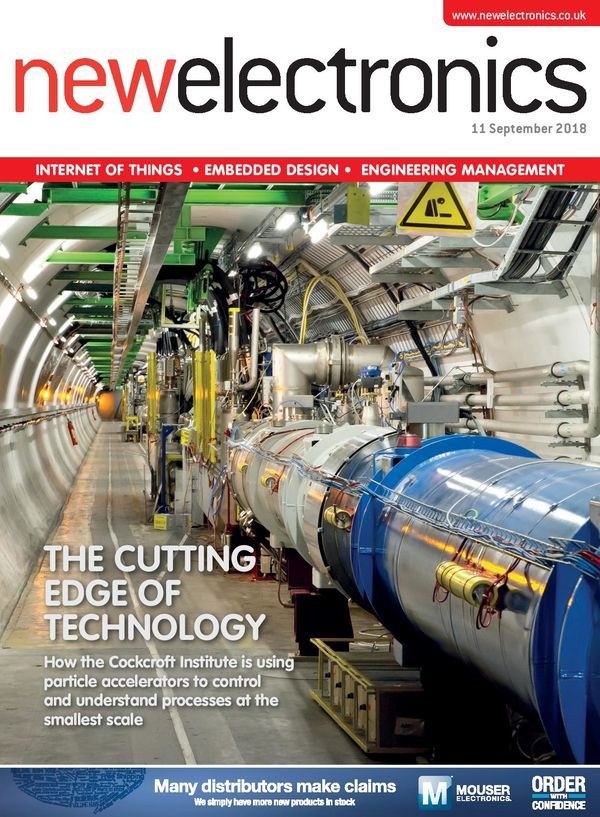
newelectronics 12 Setembro 2018
"New Electronics is a fortnightly magazine focusing on technological innovation, news and the latest developments in the electronics sector. Downloadable as a digital page turner or pdf file, or offered as a hard copy, the New Electronics magazine is available in a format to suit you. " [...]
Projetos Maker
Diversos Projetos interessantes.

Hand Motion-Controlled Robotic Arm
"This robotic arm mimics hand motion and works using sensor and moves accordingly. Can be used in industry for welding and various jobs. We are going to make a hand motion following robotic arm. This robotic arm simply follows the motion of our and and move accordingly. Such robotic arm can be widely used in industries where it requires human intelligence as well as machines help we make the work done by our hand at one place and other hundreds of robotic arm simply follows the work done by our hand so we can save time and effort and we can do job in large scale in just effort of one. So before we are going to make this we need to buy a robotic arm kit or you can make it own by 3D printer." [...]
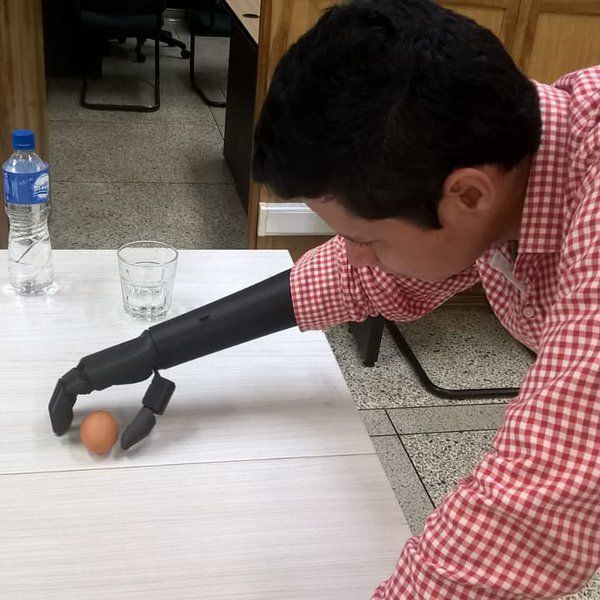
Pulse sensor to actuate a Robotic Hand
"We are trying to implement a pulse sensor to actuate a 3D printed prosthesis instead of the myoelectric ones. That's a first, we think. For the last 2 years we have been making a robotic prosthetic hand and everybody thinks its cool and all, but the same question always comes up. How is someone going to control it. We used the MyoWare Muscle Sensor for a long time and it works great, however when we started trials with Andres (he's going to come up a lot) we noticed that the way that the sensor attachs (from 3 points!) wasnt goin to work." [...]
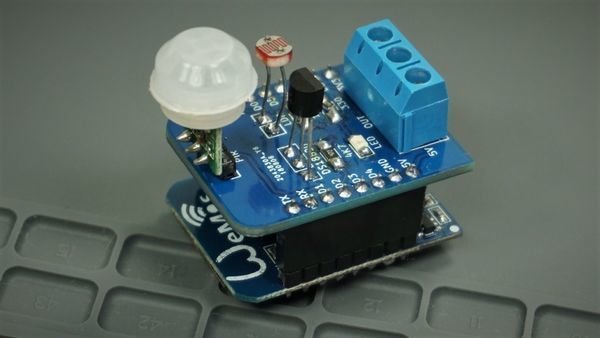
Build a Multisensor Shield for ESP8266
"In this project you’ll discover how to design and create a Multisensor Shield for the ESP8266 Wemos D1 Mini board. The shield has temperature sensor (DS18B20), a PIR motion sensor, an LDR, and a terminal to connect a relay module. We’ll start by preparing all the hardware and then program it. " [...]

LED Dancing Robots
"I wanted to make something so I could find our camp at night at Burning Man 2018. 2018 was a robot theme and I'm a fan of neon but no way was gonna head that route so I came up with an idea about a dancing cocktail glass kinda robot. We beach camp and have sand rails so I know how useful flying some kind of flag can be during the day and some kind of LED light pole is at night. So I figured, use it an burning man and keep using when we go to the beach. So using metal and welding is in my wheel house and I'm good with Arduinos so that's the medium that I chose to implement this project in. This instructable is pretty brief but any questions feel free to ask!" [...]
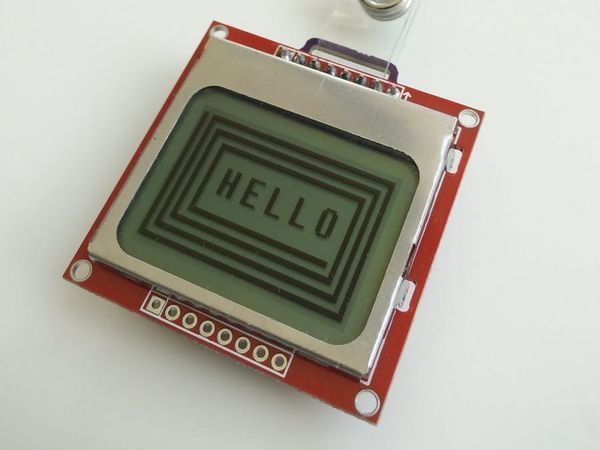
Digital Nametag
"A digital nametag based on the Nokia 3310 screen, making you interesting during fairs. This is a digital nametag based on the Nokia 3310 screen, making you interesting during fairs. Story Behind the Project Whenever I visit fairs, I often feel that I am not noticed very much. And when I do find someone to speak to, I sometimes find it hard to start a conversation. Solution The solution is a digital nametag. It can be used as a conversation starter and help show your creativity to the public." [...]

IOT Light Control Over Internet _NodeMCU ESP8266
"This tutorial is all about how to control electronic devices using WiFi technology. You have heard the name of NodeMCU ESp8266 WiFi development Board. A lot of guys wrote introductions and tons of tutorials are present here on Instructables. So, Im going to focus on NodeMCU Setup to upload Code using Arduino.ide Connecting to WiFi network and getting IP Address Controlling light using Android App over internet.Let's proceed. " [...]
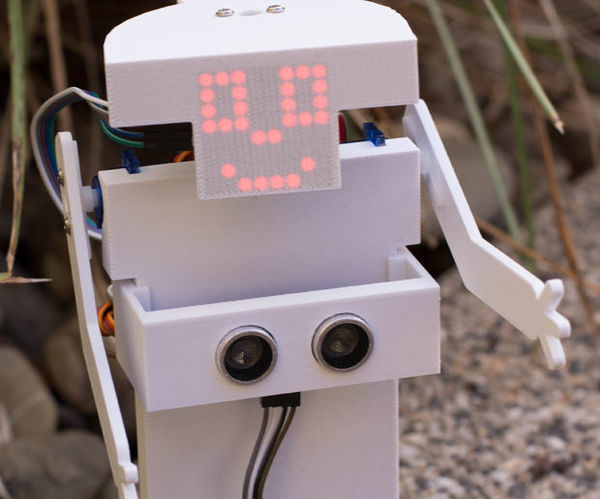
Creative Robotix - Educational Platform - Codee and Friends!
"Hey Everyone! Creative Robotix, now that's what we like! Have you ever wanted to imagine, create and make your very own humanoid robot with its very own personality? We have, so we did, and we would like to share with you what we have done. Our Creative Robotix educational platform is an open source platform designed for those who are interested in learning more about the next major market for technology, robots! Our platform provides a fun, hands-on, fully customisable and accessible experience which addresses core STEAM (Science, Technology, Engineering, Arts & Maths) learning outcomes and is suitable for groups and individuals of any age to imagine, and create their very own robot." [...]
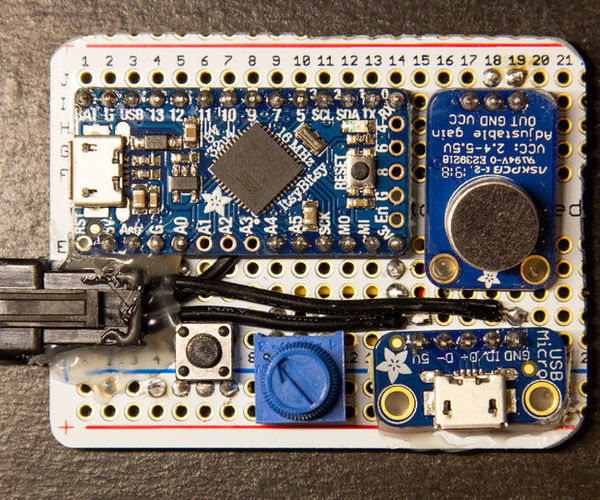
Boomstick - Animated LED Driver
"Boomstick is a project for creating an animated string of programmable RGB LEDs, powered by a small Arduino, and reactive to music. This guide focuses on one hardware configuration that you can assemble in order to run the Boomstick software. This hardware is a great size for putting into a wearable item such as a robe or spirit hood, or lighting up the length of a portable totem pole. The components include a mic (to pick up music), a knob (to adjust brightness) and a button (to switch animations). The whole unit (including LEDs) is powered from a single micro USB port, which can be plugged into a wall adapter, or a portable USB battery charger. This project is moderately difficult." [...]

ESP8266 4-Channel Relay Module Home Automation Project
"A home automation project for light use with an ESP8266 and 5V relay. " [...]

MIDI Solenoid Drummer
"This guide will show you how to build miniature percussion instrument which can be controlled via MIDI over USB. The example project is intended to serve as a jumping-off point for your own designs. Read about how I built mine, then experiment to make a unique instrument you can control with your computer. " [...]
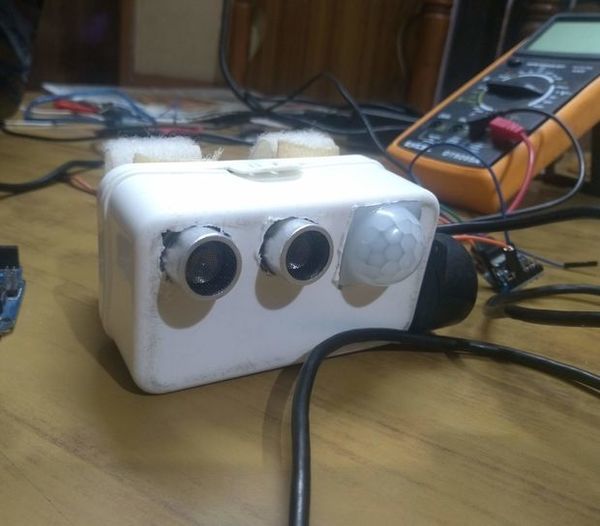
Blind Belt
"Blind belt, I tried to designed it for blind people and according to their more basic requirement. my meaning of more basic requirement is that it can sense motion of living beings and distance of obstacle. " [...]
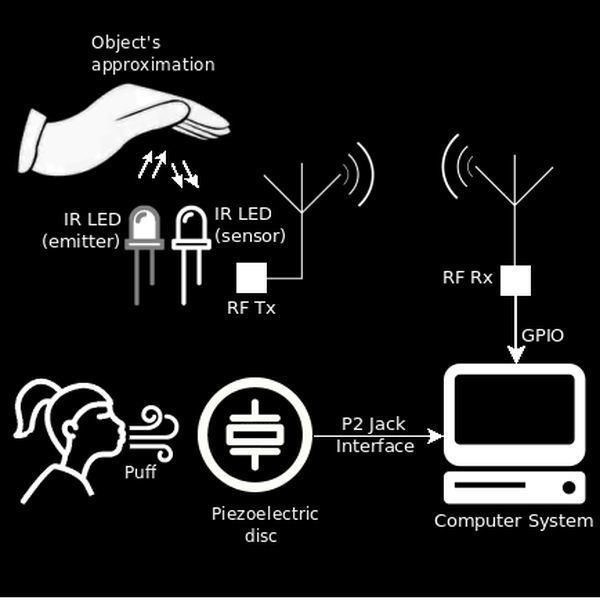
DIY Low-cost AT Switches
"Low-cost, homemade AT switches that, unlike Jelly Bean buttons, work by many forms rather than by contact or pressure This project presents two open-source, low-cost, homemade AT switches that don't work by physical contact or pressure like Jelly Bean buttons or other conventional AT switches. Instead, they work by proximity- and puff-based methods. An Infrared-based proximity switch detects the approximation of an object, while a piezoelectric sensor is responsible for sensing the air flow caused by a mouth puffing. These kind of devices could be useful for those who have upper limb weakness or paralysis, and therefore can't press buttons. DETAILS Despite the improvements achieved by the research community in the area of human-computer interaction, conventional interactions are still the most used ones for device control. However, these methods usually force the use of hands, which becomes a barrier for those who have some problem in performing upper-limb motor movements — including people with problems in fine motor skills, weakness of the fingers, etc., whose limitations are mainly concentrated at handling physical objects." [...]
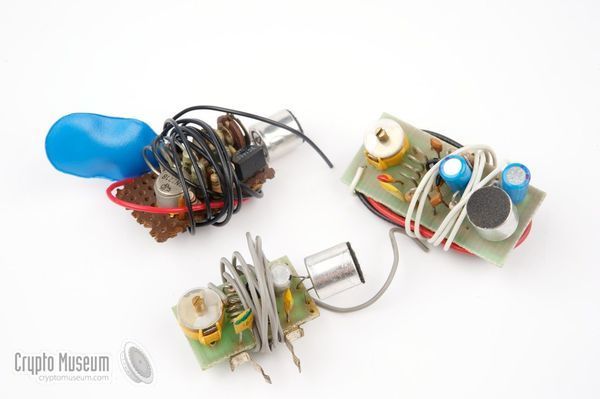
Simple FM Radio Bug
"In the mid 1970s large numbers of small FM transmitters, operating in the FM radio broadcast band (88-108 MHz) appeared on the market. It started with a self-build kit from the Danish manufacturer Jostykit that allowed everyone to build a small FM transmitter for a few Euros. Such transmitters generally consist of a single transistor oscillator with a simple resonance circuit, sometimes with an extra transistor that is used as audio pre-amplifier. The image shows a few examples that were available in European electronics shops in the mid 1970s. The transmitter shown here was built in the mid-1970s and measures just 1 x 2 cm. When properly built, it may have a range of several kilometers." [...]
GPS tracker for road-racing
"OpenSource solution for GPS video-overlay for Road-Racing. It is a high-speed (10 Hz) GPS tracker that records position and speed to an SD card, along with software to convert those positions to a nice graphical overlay to put on a video, for example from an action camera. Motivation I like building stuff. That's pretty much it. My father is a pretty good road race driver, and I though it'd be cool if I could contribute to making his videos even more interesting. By principle, I also like building things over buying them, even if they may prove inferior in some ways, I will usually know how they work, thus I will be able to utilize and service them more readily." [...]
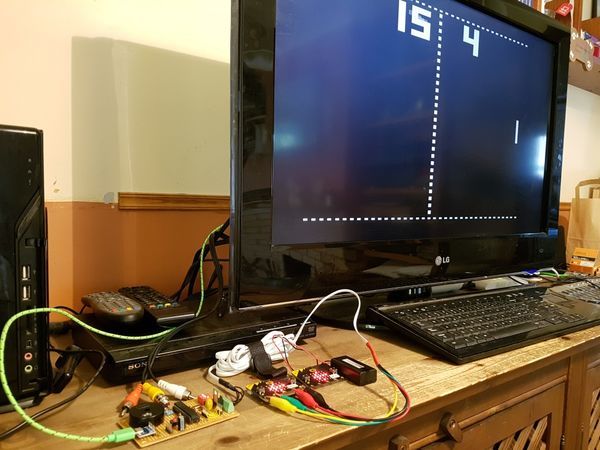
Microbit-TVPong
"Play the classic Pong game on a TV (composite video) - using BBC micro:bits as paddles. Bluetooth also supported! This is Grant Searle's fantastic Pong game for the Atmel/Microchip ATMEGA328P, modified to also support digital up/down paddles. Original code at: http://searle.hostei.com/grant/AVRPong/index.html The above page also has details of the microcontroller circuit that forms the basis of this project (with additions). The aim was to produce a fun game that could be used in STEM coding workshops using BBC micro:bits as digital game paddles. " [...]

Fingerprint Sensor Door Lock And Blackbox
"Last year I’ve made two door lock projects. One was the keypad project and the second one was an RFID door lock project each with a 3D printed case and a servo to open the door. Today I have a new one and probably the last door lock project on this channel. This is a fingerprint door lock with a black box integrated. So, why is this better than the other two projects? Well, first you don’t need to carry any key or card with you since you always have your fingerprint." [...]
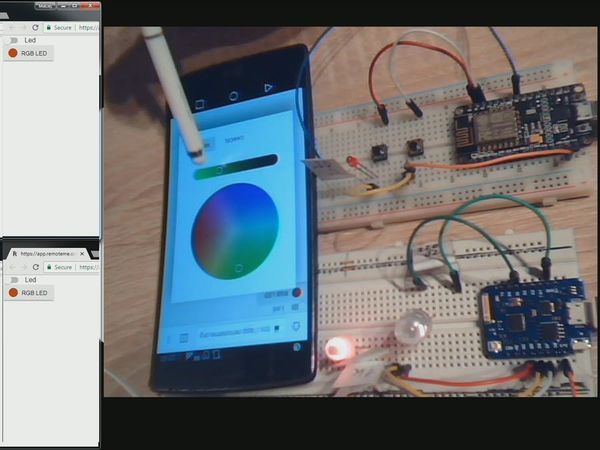
Two ESP Control by Websites or Sends Commands Between Them
"Two ESP control by webpage. ESP and webpage can be in different geographic locations (via Internet). Requires 20 lines of extra code. Hello, Why RemoteMe.org? Easy to use, free, webpages can be opened on smartphone and desktop browsers, it's accessible around the world, and features out of the box components. Assumptions Controlling one ESP for the second ESP Simultaneously controlling ESP via the website After ESP is enabled, the status is to be set to the current one ESPs do not have to be on the same local network and no public IP or tunnels etc." [...]
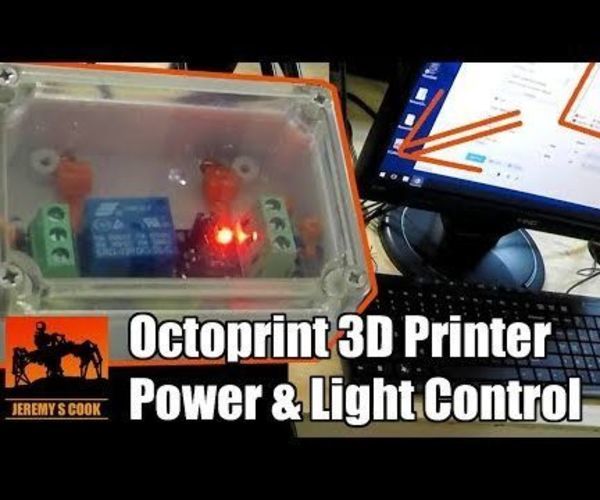
OctoPrint 3D Printer Power and Lighting Control
"If you ever wanted to turn your 3D printer on and off remotely with OctoPrint, this will show you how to do that. Additionally, a light is added; extremely helpful if you want to take time lapses and for monitoring at night. Software used: OctoPrint PSU Control Plugin OctoLapse Plugin (time lapse at end)Note that if you choose to copy anything here it's at your own risk. I'm not an electrician. " [...]
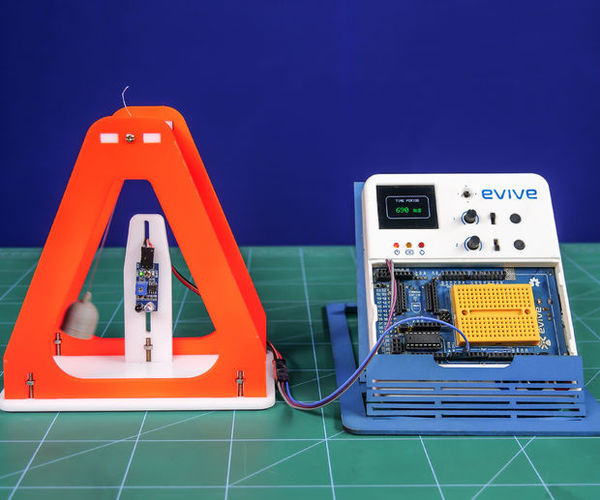
Measuring Time Period of a Pendulum Using IR Sensor
"Calculating on paper is never an easy job. And when it comes to formulas with sub-formulas of their own, it is nothing short of a nightmare! Take the case of a simple pendulum, which has a variable with a formula of its own. What if there was a way to replace these scary calculations with a simple computer program? You guessed it right! With the help of evive, an IR sensor, a computer program, and little DIYing, you can easily find out the time period of the pendulum in a matter of seconds!" [...]
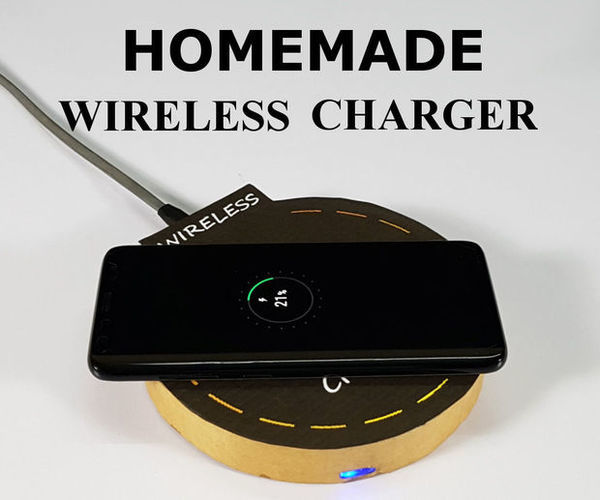
DIY - Wireless Charger
"In the last decade, Smartphones have become one of the most popular and useful gadgets. This gadget indeed a great invention has now become a necessity for everyone. Since the battery technology has not improved significantly as compared to a smartphone, we need to charge it frequently. Earlier a wired charger was an only option to charge the phone but since the inception of wireless technology, the wireless chargers are gaining pace at an impressive rate. I also needed a wireless smartphone charger as well. So, in this Instructable, i decided to make a powerful Wireless Charger for my smartphones." [...]
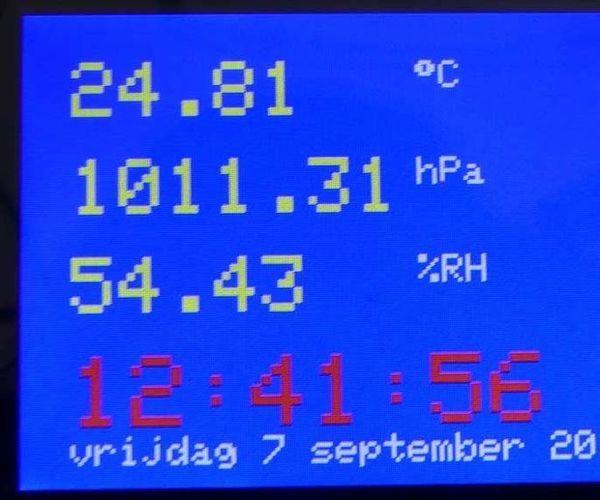
Weather Station With Metro Mini
"This weather station shows the temperature, humidity, pressure and time and date on a TFT display. It uses the Metro Mini, a RTC DS3231 module, a sensor module and a TFT display module. " [...]

The Bit
"A tongue IO device The goal of this project is to create a new input device that allows the user to control a mouse with a small sensor placed on the roof of the mouth. I imagine this HCI will benefit those who have poor/nonexistent use of their fingers or those who need to use their hands elsewhere at the same time they control a mouse. I have assembled a functional prototype that includes a bite force sensor to activate tracking (with light pressure) and to detect clicks (firm pressure). All design details will be made available. My goal is 100% open source and open hardware. " [...]
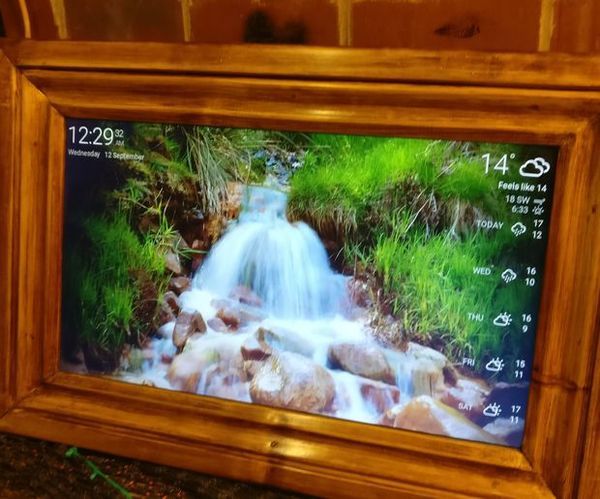
Dakboard Wall Display Wth Pi Zero W
"I work in IT. Often we get customers who would like us to remove their old kit. This usually leaves us with a pile of scrap, and monitors are one of the things we find which are wasted. At home I had upgraded my own monitors and this left my older ones sitting doing nothing so I thought about ways I could utilise them to display many of our family photos that don't often get any screen time unless we are purposefully looking through the albums. I found the website Dakboard.com and this brought about some ideas, as I had been playing with Raspberry Pi's; the 2 ideas were brought together. " [...]
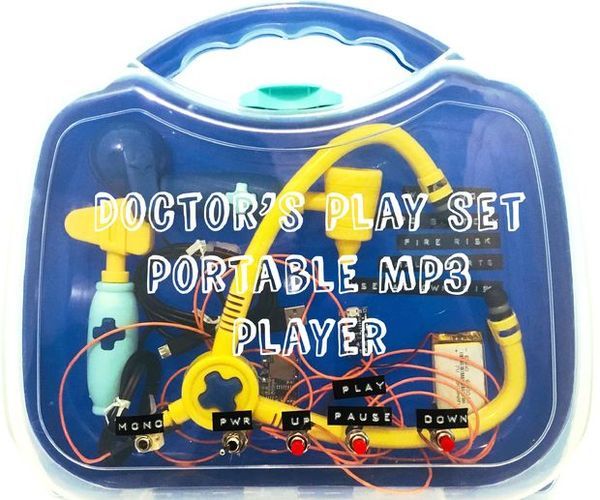
Doctors Play Set Portable MP3 Player
"I needed a gift but only had an hour to plan and build it - it also needed to have a medical theme.I had enough spare parts to build an MP3 player (having ordered two of everything for an earlier cassette tape MP3 player project - based onlonesoulsurfer's classic Instructable) and a doctor's play set which was surplus to requirement... This is a very simple project that is suitable for beginners however there are some dangers with LiPo batteries. Double check all connections Ensure there are no shorts Care for the battery properly" [...]
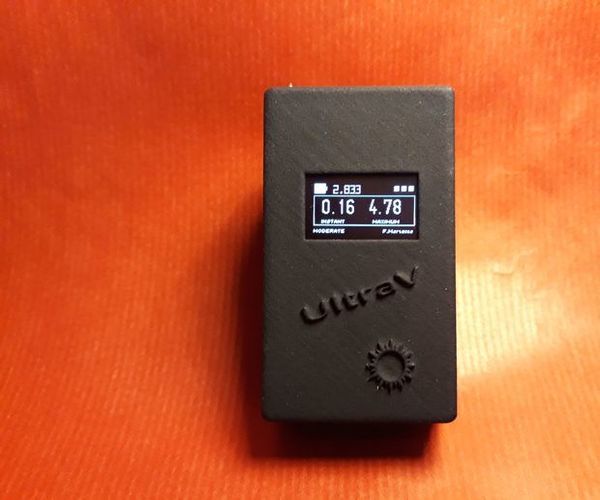
UltraV: a Portable UV-index Meter
"Being unable to expose myself to the sun due to a dermatological problem, I used the time I would have spent on the beach to build an ultraviolet rays meter. UltraV. It is built on an Arduino Nano rev3, with an UV sensor, a DC/DC converter to raise the 3v battery voltage, and a small OLED display. My main target was to keep it portable, so that I could easily know the UV-index in any moment and in any place. " [...]
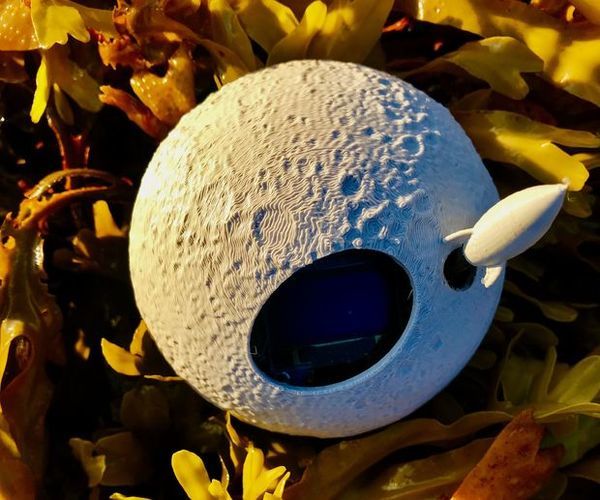
Tiny Moon Tide Clock
"This is a project being done with the Alaska SeaLife Center. They were interested in a sea-related project that would involve their students in electronic construction and monitoring of the ocean environment. The design is relatively cheap to build for a large number of students -- about $8.00. The software used is a modified version used in the large solar based tide clock but reduced in size and uses coin-cell batteries instead of solar power. I imagine with daily queries of the clock the batteries should last a couple years--and they are easily replaced. The form factors were fun to come up with and introduced me to 3D printing." [...]
Button Pixel = Bixel
"We’ve made all manner of LED displays over the years. Some simple, some complex, some tiny, some huge. But no other has been such a culmination of all the skills we’ve learned over the years. We call it the Bixel, for Button/Pixel. Ok, so we’re bad at naming things. Moving on… Every time we show off our work at Maker Faire or SparkCon we get great response from all the displays, but none more so than the interactive ones." [...]
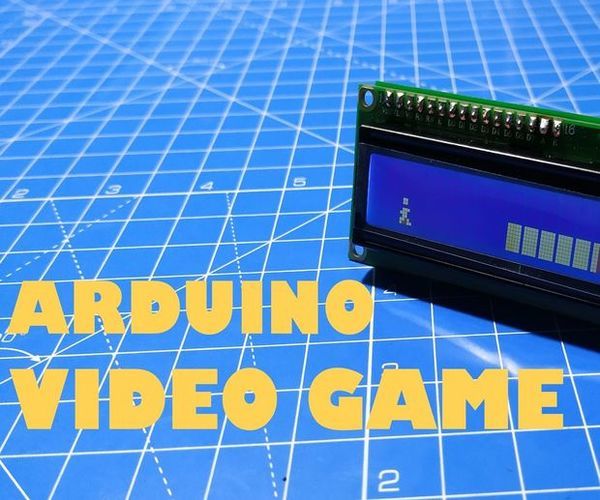
How to Make Arduino Video Game
"In this instructable, you are going to learn how to make a simple video game using Arduino. It will be best hobby projects for children. Lets get started..." [...]

Transistors 101
"At their core, transistors amplify power. Note that: power. You can use a transformer to amplify either current or voltage, but you have to trade off the other. i.e. you can get more voltage but at a lower current, or more current, but at a lower voltage. Transistors can give you an increase in both." [...]
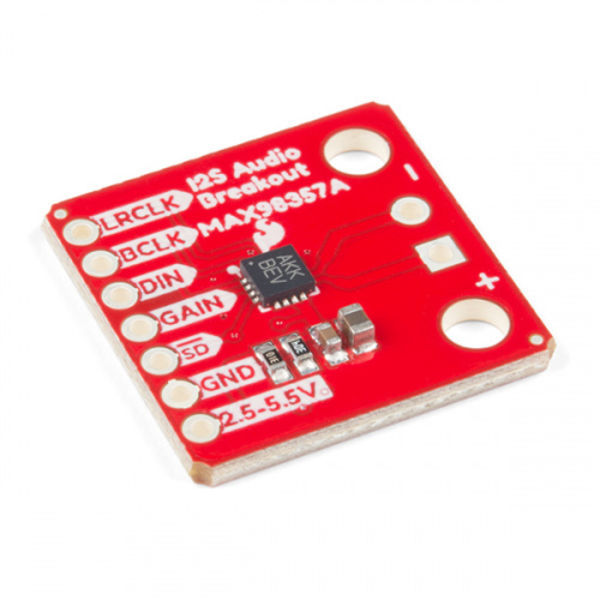
I2S Audio Breakout Hookup Guide
"Introduction The I2S Audio Breakout board uses the MAX98357A digital to analog converter (DAC), which converts I2S (not be confused with I2C) audio to an analog signal to drive speakers. The MAX98357A has a built in class D amplifier which can deliver up to 3.2W of power into a 4Ω load. For more information, see the Hardware Overview section below. Hardware Overview The I2S audio breakout converts the digital audio signals using the I2S standard to an analog signal and amplifies the signal using a class D amplifier. The board can be configured to output only the left channel, right channel, or both. For more information about how to configure the board, refer to the Jumper Selection section below." [...]
That's all Folks!


